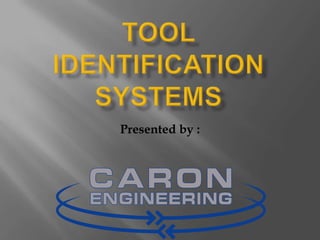
Balluff Tool Id Integration
- 2. We have been working with Tool I.D. systems since the start of the company 21 years ago. We have worked with vendors such as Balluff Peppler & Fuchs (P&F) Nedap Omron We have designed control interfaces to many of the CNC controls on the market.
- 3. CNC controls Most of the Fanuc and GEFanuc controls Okuma Mazatrol Mitsubishi Allen Bradley 9/series Haas We have worked with read only, read / write, and bar code tool I.D. systems
- 4. Two basic methods Read Only Read / Write Both types require RS232 or ethernet communications Controller can read multiple heads if required.
- 5. Central Data Plant wide network Storage Caron Engineering (ie: SQL server) CNC Interface Control (software or hardware) Tool Presetter Tool ID Tool ID controller controller Tool ID Tag Read Head Tool ID Tag Read Head (read only) (read only)
- 6. CEI interface connects to network and communicates to Central Data Storage CEI interface connects to CNC control via serial, parallel, ethernet or software only The system requires a networked central database The central database and netwrok must be up and running at all times to allow data retrieval
- 7. Tool I.D. is read at the machine Local controller queries the central data storage for tool information linked to this I.D. Length and diameter offsets are sent to the CNC control for this tool A local display can query the operator for tool offset location
- 8. Advantages Disadvantages Lower cost Requires a network Status of each running at all times machine is available Tool information via network at all must be retrieved times from network Tool life can be Tool data viewed at any time unattainable if network is down Requires a central, managed, database
- 9. Caron Engineering CNC Control Interface Tool Presetter Tool I.D. Read/Write Head Controller Read/Write Head I.D. I.D. Chip Chip
- 10. Tool information written at presetter Tool installed at machine Tool information read by local controller Length and diameter sent to machine Flag can be set in tool I.D. chip specifying the tool is used
- 11. Advantages Disadvantages No network required Higher initial cost New information can per I.D. chip be changed at the Information not machine available at the host Tool information can or network server be read at any remote station Does not require a central database
- 12. • All tools have a Balluff Read Only ID tag installed • The tool presetter measures length and diameter and writes the values to the SQL server on the plant network • Data is stored by the unique identifier on the Balluff ID tag • The tool information is then retrieved when it is loaded in to a machine
- 13. Each machine has a tool read pot mounted outside of the tool change door When the operator is ready to load a tool in the machine they insert it first in to the tool read pot When the tool ID read head senses that a tag is present, the tool load application automatically pops up on the Okuma control or PC on Fanuc control with Focas1/2
- 14. Using the unique identifier on the Balluff ID tag, all of the tool information is retrieved from the database • If the tool is OK to use the Tool can be loaded in to the magazine • The following conditions Tool Life Mismatched Tool inis Expired–Error Tool Missing –– Error Tool Tool is SetError Spindle won’t allow the operator to continue with a tool load sequence • If the Tool is not in the database • If the tool life is expired • If the tool is in the spindle • If the tool does not belong to the current part program a mismatch warning occurs
- 15. •This is a random access tool changer so the tool to pot correlation is constantly changing •On Okuma P controls and Fanuc controls with Focas1/2 we can find which pot is associated with the tool number that is going to be loaded •Our software then brings that pot to the tool load door making it easy and fool-proof for the operator to load a new tool
- 16. On Okuma P controls all of the applications reside in the control and are a software-only solution DNC-2 or Ethernet option on Fanuc control Allows data to be transferred at any time Part programs can be transferred in the background Probing data can be retrieved at any time PLC via direct I/O Requires additional machine inputs and outputs Requires re-programming of controls PLC
- 17. Most systems to date have used the Parlec or Zoller presetter Basic P.C. software can be easily setup to read and write to tool I.D. chip Any presetter can be used as long as it provides some type of output preferably RS232 or ethernet
- 18. Read Only or Read/Write ID technology? Which tool presetter will you use? Where will the tool be read at each machine? What CNC controls will be part of the system? If read only, who will maintain the database? Do you have stable plant wide network?
- 19. We have extensive experience in many different forms of tool identification systems. Typically, we have customized each system based on customer requirements. If any of the tool I.D. systems described is of interest, we are available further review of your requirements.